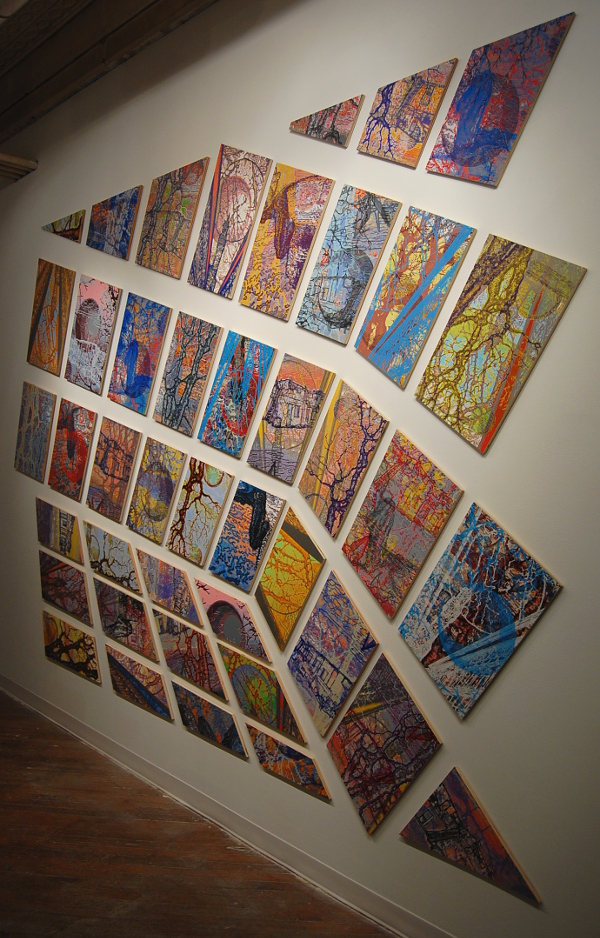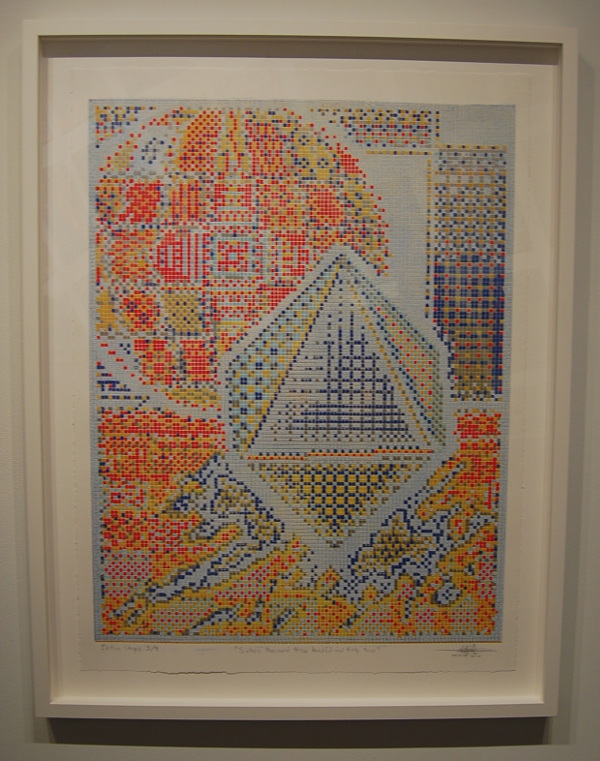
Place and process go through a metamorphosis at Napoleon
Although most of Napoleon is centered on a single installation this March, the breadth and depth of Alexis Nutini’s show “Chrysalis” is quite staggering, both visually and functionally. One side of the gallery provides a home for the immersive installation “Corner,” while the opposing wall possesses merely a single print.
There is no doubt that upon entering the space, one is immediately drawn to, and indeed overtaken by, “Corner.” At first there appears little respite from its garish palette and anomalous, disjointed patterns, but once one surrenders to the deluge, the installation begins to offer more than just a montage of layers, textures and outlines.
Nutini’s source material is the stuff of printmaking endeavors and recycled ephemera from woodblocks and paper scraps. Sliced and mounted onto birch panels bearing the shape of rectangles and rhombuses, these remnants of process and product actually take on the illusion of a room-within-a-room. Along the surface, these pieces are carefully arranged to replicate the lines that converge to form the corner of a room, paradoxically placed in the middle of a wall. This jarring play on depth is somewhat disorienting, but allows visitors to break out of the shackles of their own interpretations and set foot – almost physically – in an optical illusion.
Each segment has its own unique color scheme but shares a common visual lexicon, utilizing images of tree branches, small structures and circular shapes that exude the feeling of three-dimensional spheres—much as the flat installation seems to bend into the dimensions of an interior. The indiscernible layers, while materially flat, add their own dimensional twists and turns apart from the angles of the apparent room into which we are beckoned.
Possessing a name like “Chrysalis,” there seems to be an undeniable call for transformation nestled in among the prints. However, this call for change comes across as somewhat unclear, despite its eye-catching adroitness. Is it merely the artist’s metamorphosis? Is it our own? Is there an insistence here or just an observation of time’s ever-evolving spiral? In this environment, Nutini certainly confronts us, but leaves us suspended in anticipation much like the show’s static presence.
Alexis Nutini, “16,352.”
Across the way lies “16,352,” a humbly pixelated partner to the blocks that compose “Corner.” The aggregated shapes here are all squares–all 16,352 of them–as opposed to the carefully shaped pieces of the other work. A floating diamond form, a sphere, and a swampy foreground offer a location that seems equally unreal, yet strangely rigid. Both are prints, but this image strays further from the optical blending of its higher-resolution cousin, lending it a more grid-like appearance.
In “Chrysalis,” both works take printmaking beyond its proliferation and warp it into something else. Here we can journey through Alexis Nutini’s fragmented consciousness, which consequently challenges our own. We feel encouraged to grow and expand our perceptions of the medium, while simultaneously reel, lost in the throes of formal experimentation and strange new worlds. Napoleon will be showing “Chrysalis” through March 28.
Napoleon is located at 319 North 11th St., on the second floor, Philadelphia; [email protected]; napoleonnapoleon.com.
Recent Content
-
Artsarticle ·
-
Artsarticle ·
-
Artsarticle ·

